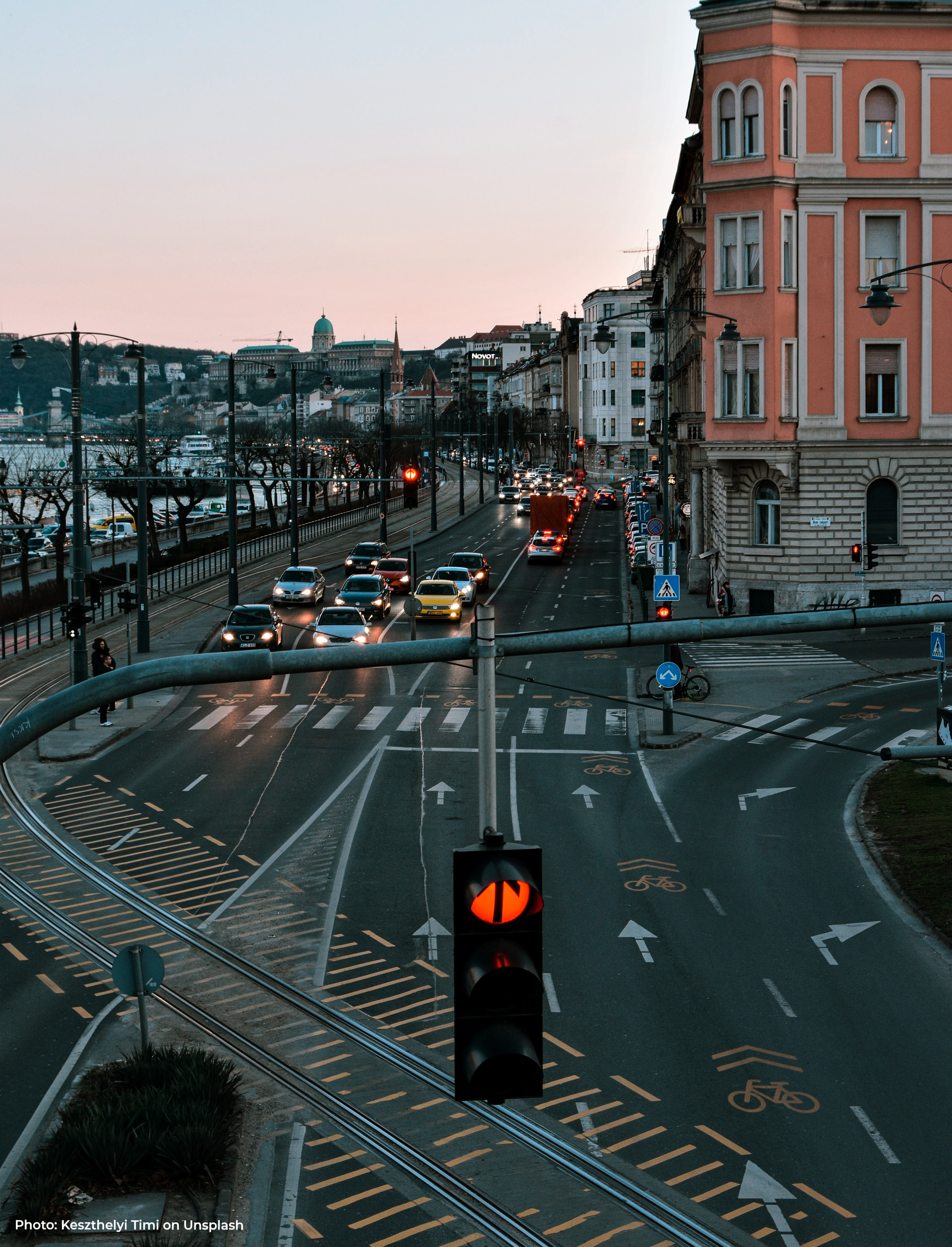SABRINA - Railway crossing signals dilemma on the border between Austria and Hungary
15-12-2020
Traffic light signals. Usually, at intersections, they have red, amber, and green light. At red one must stop; at green one can drive through. Easy. Is it really? Not if you happen to find yourself in the border regions of Austria and Hungary crossing the railway tracks. Namely, railway crossing signals work differently on each side of the border.
History of traffic light signals
The first traffic light signal was installed in London in December 1868. It had been adapted from the railroad signal system, which used red gas lights to signal danger and green lights which meant to proceed with caution. A similar system was installed in London but because of a gas leak, it exploded less than two months later and killed the police officer operating it. In 1914, Cleveland in the United States of America got the first manually controlled electric traffic signal, using the words ‘stop’ and ‘move’. Three years later the first automatic red and green electric traffic light system was introduced in San Francisco. Another three years went by before the traffic signal we know today, with amber light between the red and green, was installed in Detroit.
After the European pioneering steps into the traffic signals world in the 19th century, it took a bit longer for electric traffic signals to reach the old continent. The first one was installed in Paris in 1923. Most of the large European cities followed soon after, with Vienna and Budapest getting their first traffic light signals in 1926. Road signals and signs were into more details dealt with in the framework of an international document in 1931 when a Convention Concerning the Unification of Road Signs was signed in Geneva. Since road traffic started to rise dramatically after 1950, a conference lasting for the whole month was held in Vienna in 1968 and gathered the countries from the entire world. The Convention on Road Traffic and the Convention on Road Signs and Signals were adopted. The provisions of the latter convention were agreed upon because the contracting parties were “Recognizing that international uniformity of road signs, signals and symbols and of road markings is necessary in order to facilitate international road traffic and to increase road safety.”
Traffic light signals standardization
Chapter III of the Convention on Road Signs and Signals is dedicated to traffic light signals. The meanings of non-flashing green, red, and amber lights are described in detail. The same goes for one or two flashing red and amber lights. You may think these are all the lights used in the traffic, but the convention dedicates part of the text also to white lights. It says that “Domestic legislation may provide for the installation at certain level-crossings (note: any level intersection between a road and a railway or tramway track with its own track formation) of a slow-flashing lunar white light meaning that traffic may proceed.” Besides, we can read about vertically or horizontally arranged three- and two-colored systems, as well as about traffic light signals applying to cyclists or pedestrians only. To summarize, the traffic light signals we know today, their shapes, colors, and functioning was agreed upon in an international document, that came into force in June 1978, currently has 68 contracting parties, amongst which are also Austria and Hungary. Despite all these, we have a railway crossing signals dilemma on the border between Austria and Hungary.
Should I stay or should I go?
In general, railway crossings are high-risk meeting places for all road users. Especially the non-gated ones might lead to ‘near-miss’ or fatal situations for passengers on rail and road. In addition, certain elements of road traffic rules differ from country to country. Therefore, the lack of awareness of different road traffic regulations can lead to incorrect behavior by road users which is even more likely to have fatal consequences. Crossing the railway tracks gets confusing when one is traveling from Hungary to Austria or vice versa. It is confusing for people living in border regions, let alone for occasional or first-time visitors.
In Austria, the railway crossing signals are rectangular. In Hungary, their shape is triangular. Not a big deal since the most important is the lights. Even though there is one non-flashing red light in Austria and two alternative flashing red signals in Hungary, in both cases it means passengers must stop. This is clear and understandable. From here on things get interesting. A short yellow light - which will turn to red after four seconds - draws attention to the soon-to-arrive train in Austria. If road users can still stop safely, they must wait for the arriving train, otherwise, they have to pass through immediately. In Hungary, the railway crossing signals have a white light. When the red signals stop and the white one flashes, road users can cross the railway tracks. The white signal functions as a control signal; it only indicates the correct operation of the equipment. If the white signal is continuous, passengers can pass through the railway level crossing.
The most confusing thing happens when there are no lights. On the Austrian side of the border, no light signals mean passengers are free to pass through the railway crossing with due attention. However, in Hungary, no indicative lights at all mean the device is out of operation! Passengers shall stop in front of the level crossing and only pass through if they made sure there was no train coming (see the image below for a graphical presentation of differences; produced in the framework of the SiEBaBWe project).

Joining forces on both sides of the border
To cope with the above-mentioned phenomenon, besides implementing various traffic safety developments of existing infrastructures, Austria and Hungary joined their forces in the SiEBaBWe (Safety inspections of level crossings along the cross-border railway lines in Burgenland and western Hungary) project, co-financed by the European Regional Development Fund, the Burgenland Provincial Government, and the Hungarian National Development Agency. The project, running between 2012 and 2014, was led by the Austrian Road Safety Board (KFV), which is also the SABRINA project partner, with partners from the GYSEV/Raaberbahn (Hungarian-Austrian Railway Company) and the University of Györ. The aim of the project was to increase the safety at level crossings along the cross-border railway lines in Burgenland and western Hungary, by implementing concrete infrastructure measures as well as raising awareness among the population and increasing the subjective feeling of safety.
In the framework of the project, safety inspections were carried out at 28 selected level crossings along the Austrian-Hungarian border. By analyzing traffic habits and opinions of the users of the level crossings and considering the differences in the related regulations and rules in the two countries, several information materials have been produced. Moreover, a cross-border working group has been established involving traffic experts and representatives of the authorities with the aim to exchange knowledge and experience and build permanent cooperation between both countries in the area of cross-border safety inspections.
 Railway crossings and cyclists
Railway crossings and cyclists
The data collected in the SiEBaBWe project showed that accidents on railway crossings do happen but they can be prevented. However, we don’t know a lot about cyclists’ involvement in railway accidents. The research paper Factors influencing single-bicycle crashes at skewed railroad grade crossings pointed out that “most research on cyclist safety is focused on crashes involving light vehicles, trucks, or pedestrians. Only a few studies address single-bicycle crashes, and fewer focus on bicycle crashes at a skewed railroad grade crossing.” The study carried out near the University of Tennessee (USA) focused exactly on that and the case study they analyzed, showed one of the known hazards of the single-bicycle crashes at railway crossings was the tire interaction with the rail flangeway. The biggest determinant of this kind of crash is the approach angle. A cyclist has a much bigger possibility to safely cross the railway tracks at approach angles bigger than 30°. The accidents are almost non-existent when the angle is greater than 60°. Researchers suggested some infrastructural solutions, like realignments or “jughandle” designs of the cycling lanes to increase the approach angle to the tracks for the cyclists. According to the follow-up study published in December 2020, “the low-cost jughandle realignment reduces the crash risk of single bicycle crashes by 98% while traversing railway crossing.” There are also other infrastructural aspects we have to take into account to determine wheatear the road is safe or not for cyclists. In the SABRINA project, we will inspect a few thousand kilometers of cycling routes in the Danube area and one of the methodologies used will be the methodology from the International Road Assessment Programme (iRAP). Their sophisticated coding system takes into account many different things, amongst others also railway crossings – active and passive ones.
Unfortunately, it is true that misfortune never sleeps. Crossing the railway tracks is tricky for cyclists per se, let alone when there is no safe infrastructure in place. To also add the national railway crossing signals differences, the whole situation becomes dangerous. Since cycling is very popular in Austria and Hungary, there are also three EuroVelo routes (no. 6, 13, and 14) linking both countries, it can happen that you will also find yourself on the bike somewhere in these two countries when the winter is over. Make sure you always cross the railway tracks using caution and if possible, at a 90° angle. Besides, if your bike journey will take you to the border regions between Austria and Hungary, keep in mind the railway crossing signals dilemma. So, next time you are at the railway crossing, stop, look, and listen, admire the engineering miracle of the railway crossing signals, and continue with your journey when you are absolutely sure there is no train approaching. Better safe than sorry!
Sources:
- Budapest History Museum (2020). Budapest – Light and Shadow. Available here (Accessed 7 December 2020).
- Drive Safely (2020). The History and Meaning of Colored Traffic Lights. Available here (Accessed 7 December 2020).
- iRAP (2020). Quick Coding Guide. Available here (Accessed 7 December 2020).
- Kuratorium für Verkehrssicherheit (2015). SiEBaBWe. Available here (Accessed 7 December 2020).
- Nitesh, Shah, Buckner, Ian, and Cherry, Christopeher Robin (2020). A jughandle design will virtually eliminate single bicycle crashes at a railway crossing. Journal of Transport & Health, December 2020. Available here (Accessed 14 December 2020).
- Papadopoulos, Loukia (2020). The History and Current Use of Traffic Lights. Interesting Engineering. Available here (Accessed 7 December 2020).
- United Nations Treaty Collection (2020). Convention on Road Signs and Signals; Vienna, 8 November 1968. Available here (Accessed 7 December 2020).
- Wagner, Lise (2020). 1868–2019: a Brief History of Traffic Lights. Inclusive City Marker. Available here (Accessed 7 December 2020).
- Ziwen, Ling, Cherry, Christopeher Robin, and Dhakal, Nirbesh (2017). Factors influencing single-bicycle crashes at skewed railroad grade crossings. Journal of Transport & Health, February 2017. Available here (Accessed 7 December 2020).
![]()



